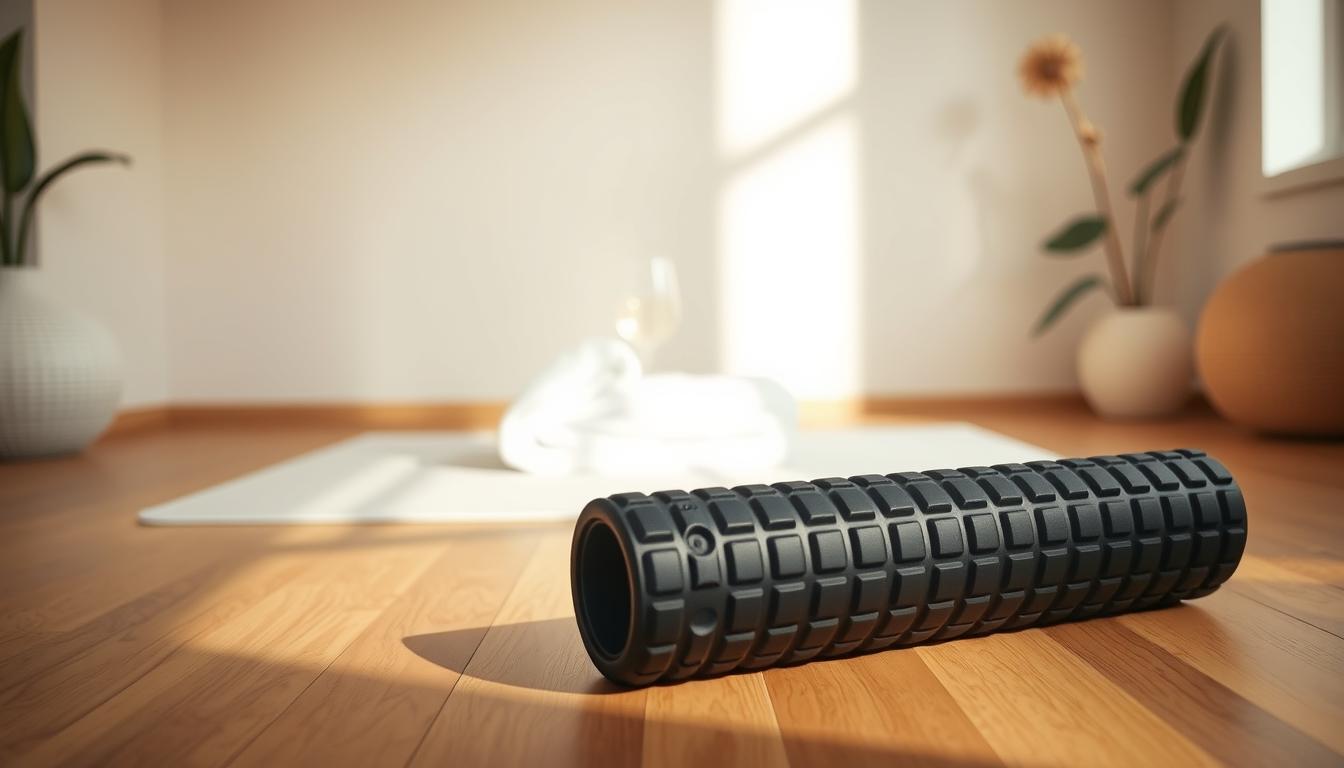In today’s digital age, neck mobility is crucial for desk workers. Many people spend long hours in front of screens. This routine aims to ease neck pain with specific exercises and ergonomic tips.
Understanding how to keep your neck healthy is vital for anyone at a workstation. Simple techniques and ergonomic workspace adjustments can reduce tension. They also boost comfort and prevent long-term posture problems.
The Importance of Neck Mobility for Computer Users
Neck mobility is key for people who use computers a lot. Spending too much time at a desk can make your neck stiff and sore. This makes it super important to keep your neck moving every day. A flexible neck means better blood flow and less muscle tightness, which helps you work better.
Doing neck exercises regularly can ease pain and stop future problems. These moves remind those who work at desks to keep a balance between work and health. Simple exercises can boost your well-being, letting you do daily tasks more easily.
Common Causes of Neck Pain for Desk Workers
Neck pain is common among those who work at desks, mainly due to a few key reasons. Poor posture is a big factor, caused by prolonged sitting at computers. Many lean over their desks or extend their heads to see their screens better, leading to muscle issues. This is often called tech neck, which happens when people stare at screens too much.
Another cause is the lack of movement that comes with desk jobs. Moving around and stretching often helps ease the pain, but it’s frequently ignored. In fact, up to 65% of people working from home report having neck and back pain. This shows a serious need for more awareness and action.
To help prevent neck pain, desk workers should check their work areas for ergonomics and make sure to move regularly. A few simple changes can really help keep your neck feeling good, even during long periods of sitting.
Understanding “Tech Neck” and Its Symptoms
Tech neck, also called text neck, is a problem for many people today. It happens when you spend too much time looking down at screens. This can cause neck and shoulder pain, tension headaches, and muscle tiredness.
Some folks might find it hard to move their necks like they used to. In bad cases, tech neck can make your arms feel numb. It’s important to pay attention to these signs early. Taking steps to fix your posture and do neck exercises is key.
How to Set Up an Ergonomic Workspace
Making your workspace ergonomic is key to lessening neck pain and boosting comfort for long hours at the computer. Put your monitor at eye level to avoid bending your neck. Choose a chair that supports your spine’s natural curve for correct posture while sitting.
Keep your feet flat on the ground for better posture. Your keyboard and mouse should be easy to reach. This reduces shoulder strain from reaching out awkwardly. Adjustable equipment also plays a big role in keeping your workspace ergonomic. As your work habits change, make sure to update your desk setup accordingly.
Neck Mobility Routine for Computer Users
Adding regular neck stretches and mobility exercises to your day helps ease tension and boost flexibility. You can easily do these movements at your desk, especially during short breaks or in-between tasks.
Simple Neck Stretches to Incorporate Daily
Begin your day with some helpful stretches. Keep these in mind:
- Gently tilt your head toward each shoulder, keeping it there for 15 to 30 seconds.
- Slowly turn your head from side to side, focusing on moving it fully.
- Lower your chin towards your chest to stretch the back of your neck.
These neck stretches increase flexibility and ease the strain of the day.
Exercises to Strengthen Neck and Upper Back Muscles
It’s vital to also work on strength in your neck. Try these exercises:
- Do chin tucks by pulling your chin back, holding briefly.
- Try shoulder blade squeezes. Pull your shoulder blades together while sitting straight.
These exercises strengthen your neck and upper back, reducing pain during long periods of computer use.
The Role of Posture in Neck Health
Good posture is key to keeping your neck healthy, especially if you sit at a desk a lot. Knowing how to sit right can help stop neck pain. It’s important because it helps your body work better, cuts down strain, and prevents injuries.
Tips for Maintaining Good Posture at Your Desk
- Sit upright with your back straight and shoulders relaxed.
- Keep your feet flat on the floor or on a footrest.
- Position your elbows close to your body at a 90-degree angle.
- Align your ears with your shoulders to avoid forward head posture.
- Incorporate breaks and stretches into your routine to prevent stiffness.
Impact of Screen Height on Neck Strain
The height of your screen plays a big role in neck strain. To keep your posture right, your monitor should be at eye level. Making these small changes helps keep your neck comfortable and can stop tech neck. This helps make a workspace that is better for your neck and overall health.

Effective Breaks: Alleviating Neck Pain with Movement
Taking short breaks at work is key to easing neck pain. Sitting too long at a computer strains your neck and upper back. Try moving every 30 to 60 minutes.
Add simple stretches, stand up, or take a quick walk during these breaks. They reset your posture and ease discomfort. This also improves blood flow and reduces neck stiffness.
Adding these breaks can boost your work output, too. Use your phone reminders or a timer to remember your breaks. Think about getting a standing desk for more movement.
Move regularly to fight neck pain and be more productive. Making this a habit leads to a healthier work life.
Daily Habits to Reduce Neck Strain
Creating daily habits is key for those who work on computers for hours. It’s vital to use technology thoughtfully. Small changes in how we use our devices can greatly improve neck health and our overall well-being.
Using Technology Mindfully
To ease neck tension, it’s important to use technology wisely. Making simple adjustments can make a big difference. These include:
- Positioning screens at eye level to minimize neck bending.
- Utilizing voice commands to reduce the need for prolonged screen gazing.
- Taking regular breaks to stretch and refresh.
Adding these practices to your daily life increases your awareness and helps reduce neck strain.
Choosing the Right Accessories for Neck Support
Neck support accessories are key to working comfortably. High-quality items make a big difference. You should consider:
- Ergonomic pillows designed to support proper alignment while sleeping.
- Lumbar supports that promote an upright sitting posture.
- Adjustable laptop stands to elevate your device to eye level.
Using these neck support tools at work helps lower neck strain and encourages good habits.
Heat and Cold Therapy for Neck Pain Relief
Heat therapy and cold therapy are great for neck pain if you use a computer a lot. Putting cold on a strained area right away helps stop swelling. It also numbs the pain. Ice packs or cold wraps work well for this.
After the worst pain is gone, heat therapy takes over. Heating pads relax tight muscles and help blood flow better. This speeds up healing. It’s good for easing the ache from too much computer time.
Using both heat and cold therapy works best for many. This mix tackles both swelling and tight muscles. It offers a full plan for easing neck pain. For desk workers, adding these steps to your day can make you feel better and move easier.
When to Seek Professional Help for Neck Pain
If you have neck pain that won’t go away, it can really affect your day-to-day life. In such cases, getting professional help is important. People who suffer from constant pain that doesn’t get better with simple home treatments should see a specialist. Chiropractors, physical therapists, and massage therapists have the right skills to treat neck pain effectively.
These experts offer treatments based on your unique needs to help reduce pain quickly and manage it over time. Chiropractors can adjust your spine to ease tension and increase movement. Physical therapists teach exercises that strengthen your neck, customized for you. Massage therapy can relax your muscles and improve blood flow, helping you heal faster.
It’s important to act fast when you have neck pain. Getting help early can stop it from becoming a long-term problem. Working together with professionals, you can get a plan made just for you, leading to better neck health.
Conclusion
Making neck mobility a priority is very important for people who use computers. It helps lessen discomfort and boosts well-being. A good neck care routine can prevent neck pain, making work more enjoyable.
Doing stretches regularly, having a good desk setup, and using tech wisely are key. It’s also important to take breaks and move around. This helps fight the bad effects of sitting too much.
By following these tips, those who work a lot on computers can create a better work setting. This isn’t just good for preventing neck pain. It also helps them stay productive and full of energy at work.



